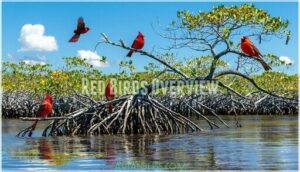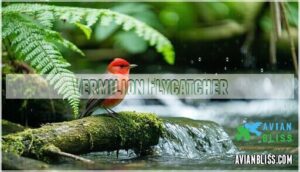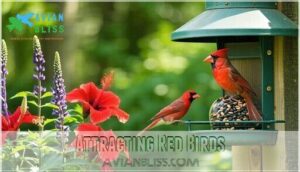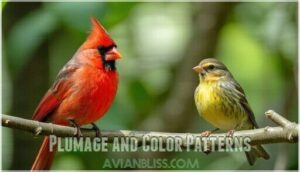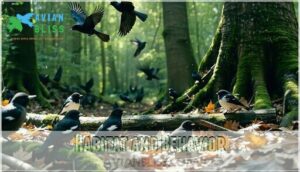This site is supported by our readers. We may earn a commission, at no cost to you, if you purchase through links.
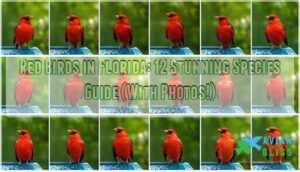 You’ll find twelve stunning red birds in Florida that’ll paint your backyard like nature’s own art gallery.
You’ll find twelve stunning red birds in Florida that’ll paint your backyard like nature’s own art gallery.
The Northern Cardinal tops the list with its brilliant crimson plumage and distinctive crest.
Summer and Scarlet Tanagers flash their ruby colors during migration seasons, while the Red-bellied Woodpecker stays year-round with its rusty cap.
House Finches bring rosy tones to suburban feeders, and if you’re lucky, you might spot the rare Vermilion Flycatcher’s fiery red chest.
These crimson beauties prefer different habitats – from oak hammocks to your own backyard feeders.
Timing, location, and the right food sources make all the difference in attracting these feathered gems.
Table Of Contents
- Key Takeaways
- Red Birds Overview
- Types of Red Birds
- Red Birds by Season
- Attracting Red Birds
- Identifying Red Birds
- Frequently Asked Questions (FAQs)
- What red bird lives in Florida?
- What is the red bird that is not a cardinal?
- How common are red cardinals in Florida?
- What time of year are cardinals in Florida?
- What are the red crested birds in Florida?
- What is the red bird but not a cardinal?
- Are red cardinals in Florida?
- How long do cardinals live in Florida?
- What do red birds in Florida eat?
- How long do Floridas red birds live?
- Conclusion
Key Takeaways
- You’ll find 12 stunning red bird species in Florida, with the Northern Cardinal being the most common year-round resident sporting brilliant crimson plumage and a distinctive crest.
- You can attract these red birds to your yard by offering black oil sunflower seeds, safflower seeds, and planting native nectar-producing flowers like cardinal flower and trumpet vine.
- You’ll need to look at specific features for proper identification – cardinals have thick conical beaks for seed-cracking, while tanagers display shorter bills for insect-catching, and size varies from 5-inch finches to 9-inch cardinals.
- You’ll spot different species during various seasons – some like cardinals stay year-round, while Scarlet and Summer Tanagers only pass through during spring and fall migration periods.
Red Birds Overview
You’ll find over 12 stunning red bird species calling Florida home, from the familiar Northern Cardinal to the brilliant Scarlet Tanager.
These colorful visitors and year-round residents make up about 2-3% of Florida’s bird population, using their bright red feathers to attract mates and claim territory.
Northern Cardinal
The Northern Cardinal stands as Florida’s most beloved red bird, with males sporting brilliant scarlet plumage year-round.
Florida’s cardinal reigns supreme—a crimson crown jewel that never fades, bringing year-round brilliance to every backyard.
You’ll spot these backyard birds florida favorites in gardens and woodlands statewide.
Cardinal characteristics you’ll notice:
- Males display vibrant red cardinal florida coloration with black face masks
- Cardinal plumage differs between sexes – females show warm brown tones
- Cardinal song features clear whistles like "birdy-birdy-birdy"
- Cardinal diet includes seeds, fruits, and insects
Scarlet Tanager
You’ll spot the stunning Scarlet Tanager during spring migration in Florida’s forests.
Male plumage features brilliant red with jet-black wings, while female appearance shows olive-green coloring for camouflage.
These red birds in florida prefer dense forest habitat where they maintain an insect diet.
Their migration patterns bring them through Florida briefly, making sightings special for florida birds enthusiasts seeking red bird identification opportunities.
The males’ vivid plumage is an example of sexual dimorphism, which is a key aspect of their biological characteristics and plays a role in mate attraction and species identification.
Summer Tanager
You’ll easily recognize the Summer Tanager by its completely strawberry-red plumage – it’s North America’s only entirely red bird.
Florida’s only entirely red bird – the Summer Tanager’s strawberry plumage makes identification effortless for backyard birdwatchers.
These medium-sized songbirds prefer Florida’s open woodlands and forest canopies, where they hunt flying insects with remarkable precision.
The males’ vibrant colors come from carotenoid rich diets.
Summer Tanager Florida Identification Features:
- Males display vibrant red plumage year-round
- Females show mustard-yellow coloration with olive tones
- Thick, sturdy bills perfect for catching bees and wasps
- Measures 6.7 inches with distinctive languid movements
- Produces lazy robin-like songs from treetops
Finch Species
Two finch species grace Florida’s landscapes with their vibrant red plumage.
House Finch males display rosy-red heads and breasts, while Purple Finch males showcase deeper raspberry-red coloration.
These seed-eating songbirds frequent backyards, parks, and weedy fields.
You’ll spot them at feeders enjoying sunflower seeds.
Their conical beaks perfectly crack open seeds, making finch identification straightforward for Florida birdwatchers.
Types of Red Birds
You’ll discover four main types of red birds that call Florida home year-round or visit during specific seasons.
These species range from the familiar American Robin with its rusty-red breast to the striking Vermilion Flycatcher that brightens open areas with its brilliant crimson plumage.
American Robin
You’ll recognize the American Robin by its distinctive reddish-orange breast, though it’s not entirely red like other Florida birds.
This familiar songbird showcases subtle red markings that make it worth including in your bird identification journey.
Key American Robin features:
- Dark gray head contrasting with bright orange-red breast
- White eye-ring and throat markings for easy identification
- Ground-hopping Robin Behavior while searching for worms and insects
Robin Migration patterns bring these birds to Florida during winter months, where they gather in large flocks.
Their Robin Diet shifts from insects to berries, making backyards with fruit trees ideal Robin Habitat.
You’ll spot their Robin Nesting activities in early spring before they head north.
Red-bellied Woodpecker
Despite its name, the Red-bellied Woodpecker displays more red on its head than belly.
You’ll find this Florida bird hammering oak trees for acorns and insects. Their habitat preference includes mature forests and suburban areas with large trees.
These vocal birds produce rolling calls while searching for food. Their diet specifics include nuts, fruits, and tree-dwelling insects year-round.
Red plumage can play a role in establishing dominance during food competition, which is a key aspect of their behavior, and this red plumage is particularly notable, as it helps in establishing social hierarchy.
House Finch
Originally a western species, the House Finch showcases remarkable Range Expansion across Florida through impressive Urban Adaptation.
You’ll spot males displaying vibrant Male Plumage—rosy-red heads and breasts contrasting with brown-streaked bodies.
Their Social Behavior makes them delightful backyard visitors.
- Seed Preferences include sunflower seeds and nyjer at feeders
- Red birds in florida thrive in residential areas and parks
- Bird identification guides highlight their notched tails and conical beaks
Vermilion Flycatcher
You’ll spot the Vermilion Flycatcher’s brilliant red plumage creating stunning contrast against Florida’s landscapes.
This small red bird species measures just 5.5 inches with striking plumage variation between males and females.
Their flycatching behavior involves perching low and swooping for insects.
While regional sightings remain uncommon in Florida, their habitat preferences include open areas near water sources.
Red Birds by Season
You’ll notice Florida’s red birds follow distinct seasonal patterns, with some species staying year-round while others visit during specific months.
Understanding these timing patterns helps you know exactly when to look for cardinals in your backyard versus when migrating tanagers might pass through your area.
Year-Round Residents
Some red birds in florida call the Sunshine State home all year long.
These permanent residents don’t pack their bags for seasonal trips—they’ve found their perfect Florida wildlife paradise.
- Northern Cardinals dominate Cardinal Habitats from woodlands to your backyard
- Red-headed Woodpeckers showcase stunning Plumage Variations across forests
- House Finches demonstrate remarkable Finch Adaptations in urban areas
- Resident Diets vary from seeds to insects, supporting year-round survival
Migratory Birds
Some red birds in florida follow fascinating migration patterns that’ll make your head spin.
Scarlet Tanagers and Summer Tanagers journey thousands of miles, using stopover sites to refuel.
Climate change and habitat loss threaten these incredible journeys, making conservation efforts more critical than ever.
You’ll spot these travelers during spring and fall as they navigate bird migration patterns through the Sunshine State.
Winter Visitors
Several species join Florida’s red bird community during winter months.
Winter finches arrive from northern regions, seeking warmer temperatures and abundant food sources.
Cardinal behavior remains consistent, but habitat changes bring new opportunities.
Northern Cardinal populations may increase with migrating relatives.
House Finch numbers grow as northern birds move south.
Migration patterns bring diverse red species to Florida’s welcoming landscapes, with winter finches and Northern Cardinal populations, and diverse red species.
Summer Breeders
While winter visitors head north, Florida’s summer breeders arrive ready for action.
Summer Tanager Florida populations establish breeding territories in dense woodlands, displaying vibrant breeding plumage that attracts mates.
Their dedicated parental care and strategic nesting habits guarantee successful reproduction throughout Florida’s warm breeding season.
Attracting Red Birds
You can transform your yard into a red bird paradise by offering the right mix of seeds, suet, and nectar-rich flowers that these colorful species crave.
Set up multiple feeders with black oil sunflower seeds and safflower seeds, then plant native flowering shrubs to create an irresistible buffet that’ll have cardinals, tanagers, and finches visiting regularly, making your yard a haven for these colorful species.
Food Preferences
Understanding red birds’ dining preferences helps you create an irresistible backyard buffet.
These colorful visitors have diverse tastes that change with seasons and species.
- Seed choices: Cardinals love sunflower seeds, while finches prefer nyjer and millet
- Fruit diets: Summer tanagers enjoy berries and tree fruits for energy
- Insect consumption: Protein-rich bugs fuel breeding season activities
- Feeder types: Tube feeders work best for smaller seeds
- Foraging habits: Ground-hopping species need scattered food below
Consider bulk sunflower seed options for frequent visitors.
Nectar-Producing Flowers
Beyond seeds and suet, flowering plants create irresistible magnets for red birds in Florida.
Hummingbird Favorites like trumpet vine and cardinal flower provide essential Native Nectar that attracts Ruby-throated Hummingbirds year-round.
These vibrant blooms support both resident cardinals and migrating tanagers during their Florida birdwatching adventures.
You can find various cardinal flower products online.
| Plant Name | Flower Colors | Bloom Times | Bird Species Attracted | Habitat Type |
|---|---|---|---|---|
| Cardinal Flower | Bright red | Summer-Fall | Hummingbirds, Cardinals | Wetland edges |
| Trumpet Vine | Orange-red | Spring-Summer | Hummingbirds, Tanagers | Garden borders |
| Coral Honeysuckle | Red-orange | Year-round | Multiple species | Butterfly Gardens |
| Firebush | Orange-red | Fall-Winter | Hummingbirds, Finches | Native landscapes |
| Salvia | Red, purple | Spring-Fall | Hummingbirds, Cardinals | Drought-tolerant areas |
Bird Feeders
Bird feeders transform your yard into a red bird paradise. Strategic feeder placement near shrubs gives birds quick escape routes while offering clear viewing for you.
Different red birds in florida prefer specific bird seed types and feeding stations.
- Tube feeders work best for finches and smaller red birds
- Platform feeders attract cardinals and tanagers effectively
- Hopper feeders accommodate various bird attraction tips and species
Many options are available for purchasing quality feeders.
Suet and Seeds
Beyond basic feeders, suet and seeds create an irresistible buffet for red birds in florida. Mix peanut butter with cornmeal for homemade suet recipe ideas that cardinals adore.
Store bird seed types in airtight containers to maintain seed nutritional value. Cardinals prefer black oil sunflower seeds, while tanagers enjoy nyjer.
| Seed Type | Red Bird Species |
|---|---|
| Black Oil Sunflower | Northern Cardinals, House Finches |
| Nyjer (Thistle) | Purple Finches, Summer Tanagers |
| Safflower Seeds | Cardinals (squirrel-resistant option) |
| Mixed Seed Blend | Multiple species attraction |
| Suet Cakes | Woodpeckers, Winter visitors |
Strategic feeder placement tips include positioning feeders near shrubs for cover. Proper seed storage methods prevent spoilage and waste.
Understanding suet bird preferences helps attract diverse species year-round through targeted bird attraction tips. Suet is a high-calorie option, especially beneficial during food-scarce winter months.
Identifying Red Birds
You’ll need to examine several key features to correctly identify Florida’s red birds, including their size, beak shape, and specific color patterns.
Look closely at whether the red covers the entire body or just specific areas like the head or breast, as this helps distinguish between species like cardinals and finches.
Length and Wingspan
Size matters when identifying Florida’s red birds. Cardinal Size averages 8-9 inches with 10-12 inch wingspans, while Tanager Dimensions measure 6-8 inches.
These bird characteristics help distinguish species at a glance.
Here’s your Species Comparison guide:
- Small red birds (5-6 inches): House Finch and Purple Finch with compact Finch Proportions
- Medium birds (6-8 inches): Tanagers and Summer Tanagers with moderate wingspans
- Large birds (8-9 inches): Cardinals dominating with impressive Flycatcher Length measurements
Plumage and Color Patterns
You’ll notice striking differences in red birds’ plumage patterns.
Male coloration ranges from the cardinal’s vibrant scarlet to the tanager’s deep crimson with black wings.
Female dimorphism shows more subdued tones – cardinals display warm brown with red tinges, while tanager females appear yellowish-green.
Plumage changes occur seasonally, affecting color intensity and feather structure for bird identification purposes.
Beak Shape and Size
Looking at bird bill shapes reveals each species’ dining preferences like a biological menu.
Cardinals sport thick, conical beaks perfect for seed cracking, while tanagers have shorter, stouter bills for insect catching. House finches show classic seedeating bill morphology with their triangular shape.
Summer tanagers display feeding adaptations with blunt-tipped bills ideal for bee hunting. Bill size directly correlates with preferred food sources.
These variations are essential for bird identification basics.
Habitat and Behavior
You’ll recognize red birds by their distinct habitat preferences and behaviors across Florida’s diverse ecosystems.
Each species exhibits unique patterns that make identification easier when you know what to watch for.
Key behavioral markers include:
- Nesting Habits – Cardinals prefer dense shrubs while tanagers choose tall canopy branches
- Foraging Strategies – Ground-feeding finches versus bark-probing woodpeckers show different hunting styles
- Social Interactions – Some flock together while others remain solitary
- Territorial Defense – Males display aggressive posturing during mating rituals
Frequently Asked Questions (FAQs)
What red bird lives in Florida?
Birds of a feather flock together," and you’ll spot the Northern Cardinal year-round in Florida.
Males display brilliant red plumage with black masks, while females show brownish-red tones.
They’re Florida’s most common red bird species.
What is the red bird that is not a cardinal?
You’ll spot several non-cardinal red birds in Florida.
Summer Tanagers display brilliant red plumage, while House Finches show rosy-red heads and breasts.
Scarlet Tanagers feature striking red bodies with black wings during migration seasons.
How common are red cardinals in Florida?
Like peas in a pod, Northern Cardinals are Florida’s most abundant red bird species.
You’ll find them year-round throughout the state, thriving in woodlands, gardens, and residential areas with their adaptable nature and varied diet.
What time of year are cardinals in Florida?
You’ll find cardinals in Florida year-round since they’re permanent residents. Unlike migratory birds, these red beauties don’t leave for winter, making them reliable backyard visitors throughout all seasons.
What are the red crested birds in Florida?
Cardinal royalty reigns supreme among Florida’s crested red birds.
You’ll spot Northern Cardinals with their iconic pointed crowns year-round.
Males flaunt brilliant scarlet plumage while females sport subtle reddish-brown crests throughout the state’s diverse habitats, with the Northern Cardinals being a prime example of royalty.
What is the red bird but not a cardinal?
Several red birds in Florida aren’t cardinals.
You’ll see Scarlet Tanagers with black wings, Summer Tanagers that’re completely red, House Finches with rosy-red heads, and Purple Finches sporting raspberry-red plumage during winter months.
Are red cardinals in Florida?
Crimson crowns grace the Sunshine State year-round.
You’ll spot Northern Cardinals throughout Florida’s woodlands, gardens, and backyards.
These vibrant red beauties with their distinctive crests call Florida home permanently, not just seasonal visitors.
How long do cardinals live in Florida?
You’ll typically see cardinals living 3-4 years in Florida’s wild, though some fortunate birds reach 15 years. Backyard feeders, predator-safe nesting spots, and Florida’s mild climate help extend their lifespans considerably.
What do red birds in Florida eat?
You’ll find red birds dining on seeds, fruits, and insects throughout Florida.
Cardinals love sunflower seeds, tanagers prefer berries, while finches enjoy mixed seeds.
They’ll visit your feeders for easy meals year-round, and throughout Florida is where you can observe this behavior.
How long do Floridas red birds live?
Like living jewels that brighten your backyard, Florida’s red birds typically live 6-15 years in the wild.
Cardinals often reach 15 years, while smaller species like finches average 4-11 years, depending on predators and environmental factors, which can be considered complete concepts in understanding the lifespan of these birds.
Conclusion
Picture yourself stepping outside tomorrow morning with newfound knowledge about red birds in Florida.
You’ll recognize the Northern Cardinal’s bright crest, spot Summer Tanagers during migration, and appreciate the Red-bellied Woodpecker’s year-round presence.
Whether you’re filling feeders with sunflower seeds or planting native flowers, you’re now equipped to attract these crimson beauties to your yard.
Start watching for these twelve species – your backyard birding adventures will never be the same again.

